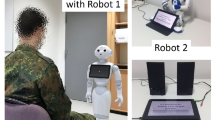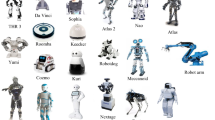Abstract
An emerging research trend associating social robotics and social-cognitive psychology offers preliminary evidence that the mere presence of humanoid robots may have the same effects as human presence on human performance, provided the robots are anthropomorphized to some extent (attribution to mental states to the robot being present). However, whether these effects also depend on the evaluation potential of the robot remains unclear. Here, we investigated this critical issue in the context of the Stroop task allowing the estimation of robotic presence effects on participants’ reaction times (RTs) to simple and complex stimuli. Participants performed the Stroop task twice while being randomly assigned to one of three conditions: alone then in the presence of a robot presented as competent versus incompetent on the task at hand (“evaluative” vs. “nonevaluative” robot condition), or systematically alone (control condition). Whereas the presence of the incompetent robot did not change RTs (compared to the control condition), the presence of the competent robot caused longer RTs on both types of Stroop stimuli. The robot being exactly the same in both conditions, to the notable exception of its evaluation potential, these findings indicate that the presence of humanoid robots with such a potential may divert attention away from the central task in humans.
Supported by MITI/CNRS and MIAI@Grenoble Alpes (ANR-19-P3IA-0003).
Access this chapter
Tax calculation will be finalised at checkout
Purchases are for personal use only
Similar content being viewed by others
References
Augustinova, M., Parris, B.A., Ferrand, L.: The loci of stroop interference and facilitation effects with manual and vocal responses. Front. Psychol. 10, 1786 (2019)
Augustinova, M., Silvert, L., Spatola, N., Ferrand, L.: Further investigation of distinct components of stroop interference and of their reduction by short response-stimulus intervals. Acta Psychologica 189, 54–62 (2018)
Bainbridge, W.A., Hart, J., Kim, E.S., Scassellati, B.: The effect of presence on human-robot interaction. In: RO-MAN 2008-The 17th IEEE International Symposium on Robot and Human Interactive Communication, pp. 701–706. IEEE (2008)
Baumeister, R.F.: Choking under pressure: self-consciousness and paradoxical effects of incentives on skillful performance. J. Personal. Soc. Psychol. 46(3), 610 (1984)
Belletier, C., et al.: Choking under monitoring pressure: being watched by the experimenter reduces executive attention. Psychonomic Bull. Rev. 22(5), 1410–1416 (2015). https://doi.org/10.3758/s13423-015-0804-9
Belletier, C., Normand, A., Huguet, P.: Social-facilitation-and-impairment effects: from motivation to cognition and the social brain. Curr. Directions Psychol. Sci. 28(3), 260–265 (2019)
Boucher, J.D., et al.: I reach faster when i see you look: gaze effects in human-human and human-robot face-to-face cooperation. Front. Neurorob. 6, 3 (2012)
Huguet, P., Barbet, I., Belletier, C., Monteil, J.M., Fagot, J.: Cognitive control under social influence in baboons. J. Exp. Psychol. Gen. 143(6), 2067 (2014)
Kiesler, S., Powers, A., Fussell, S.R., Torrey, C.: Anthropomorphic interactions with a robot and robot-like agent. Soc. Cogn. 26(2), 169–181 (2008)
Kimble, C.E., Rezabek, J.S.: Playing games before an audience: social facilitation or choking. Soc. Behav. Personal. Int. J. 20(2), 115–120 (1992)
Li, J.: The benefit of being physically present: a survey of experimental works comparing copresent robots, telepresent robots and virtual agents. Int. J. Hum.-Comput. Stud. 77, 23–37 (2015)
MacLeod, C.M.: Half a century of research on the stroop effect: an integrative review. Psychol. Bull. 109(2), 163 (1991)
Parris, B.A., Hasshim, N., Wadsley, M., Augustinova, M., Ferrand, L.: The loci of stroop effects: A critical review of methods and evidence for levels ofprocessing contributing to colour-word stroop effects and the implications for the loci ofattentional selection. Psychological Research (2021)
Riether, N., Hegel, F., Wrede, B., Horstmann, G.: Social facilitation with social robots? In: 2012 7th ACM/IEEE International Conference on Human-Robot Interaction (HRI), pp. 41–47. IEEE (2012)
Robins, B., Dautenhahn, K., Te Boekhorst, R., Billard, A.: Robotic assistants in therapy and education of children with autism: can a small humanoid robot help encourage social interaction skills? Univ. Access Inform. Soc. 4(2), 105–120 (2005)
Spatola, N., et al.: Improved cognitive control in presence of anthropomorphized robots. Int. J. Soc. Robot. 11(3), 463–476 (2019)
Spatola, N., et al.: Not as bad as it seems: when the presence of a threatening humanoid robot improves human performance. Sci. Robot. 3(21), eaat5843 (2018)
Spatola, N., Kühnlenz, B., Cheng, G.: Perception and evaluation in human-robot interaction: The human-robot interaction evaluation scale (hries)-a multicomponent approach of anthropomorphism. International Journal of Social Robotics, pp. 1–23 (2021)
Wainer, J., Feil-Seifer, D.J., Shell, D.A., Mataric, M.J.: The role of physical embodiment in human-robot interaction. In: ROMAN 2006-The 15th IEEE International Symposium on Robot and Human Interactive Communication, pp. 117–122. IEEE (2006)
Wainer, J., Feil-Seifer, D.J., Shell, D.A., Mataric, M.J.: Embodiment and human-robot interaction: a task-based perspective. In: RO-MAN 2007-The 16th IEEE International Symposium on Robot and Human Interactive Communication, pp. 872–877. IEEE (2007)
Zajonc, R.B.: Social facilitation. Science 149(3681), 269–274 (1965)
Zajonc, R.B., Heingartner, A., Herman, E.M.: Social enhancement and impairment of performance in the cockroach. J. Personal. Soc. Psychol. 13(2), 83 (1969)
Zeng, Z., Chen, P.J., Lew, A.A.: From high-touch to high-tech: Covid-19 drives robotics adoption. Tourism Geograph. 22(3), 724–734 (2020)
Author information
Authors and Affiliations
Corresponding author
Editor information
Editors and Affiliations
Rights and permissions
Copyright information
© 2021 Springer Nature Switzerland AG
About this paper
Cite this paper
Koelsch, L., Elisei, F., Ferrand, L., Chausse, P., Bailly, G., Huguet, P. (2021). Impact of Social Presence of Humanoid Robots: Does Competence Matter?. In: Li, H., et al. Social Robotics. ICSR 2021. Lecture Notes in Computer Science(), vol 13086. Springer, Cham. https://doi.org/10.1007/978-3-030-90525-5_64
Download citation
DOI: https://doi.org/10.1007/978-3-030-90525-5_64
Published:
Publisher Name: Springer, Cham
Print ISBN: 978-3-030-90524-8
Online ISBN: 978-3-030-90525-5
eBook Packages: Computer ScienceComputer Science (R0)




